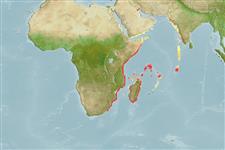>
Kurtiformes (Nurseryfishes, cardinalfishes.) >
Apogonidae (Cardinalfishes) > Apogoninae
Etymology: Taeniamia: Name from feminine Latin noun 'taenia' meaning ribbon or band; and feminine Greek noun 'Amia' meaning a fish, often used with cardinalfishes genera. Here as Taeniamia referring to the vertical wide bars and near vertical to curved narrow bars as lines on most of the species in this genus..
More on author: Smith.
Environment: milieu / climate zone / depth range / distribution range
Ecologia
marinhas associadas(os) a recifes; intervalo de profundidade 1 - 20 m (Ref. 9710). Tropical
Western Indian Ocean: eastern coast of Africa and its associated islands, from Kenya to KwaZulu-Natal (Ref. 54391). Reported as likely at Seychelles (Ref. 1623) but Randall and van Egmond 1994 (Ref. 10685) believe otherwise.
Tamanho / Peso / Idade
Maturity: Lm ? range ? - ? cm
Max length : 8.9 cm SL macho/indeterminado; (Ref. 54391)
Descrição breve
Chaves de identificação | Morfologia | Morfometria
Espinhos dorsais (total) : 7; Raios dorsais moles (total) : 9; Espinhos anais: 2; Raios anais moles: 13 - 15. Diagnosis: Rays: dorsal VI + I,9; anal II,13-15; pectoral rays 14 (rarely 15). Gill rakers 5-6 + 16-18. Lateral-line scales 25+3-4. Median predorsal scales 5-6. Body depth 2.5-2.7 in SL; body width 2.2-2.6 in body depth; eye diameter 2.8-3.2 in head length; first dorsal spine 2.5-3.25 in second spine; second dorsal spine 2.05-2.8, and third dorsal spine 2.1-2.9 in head length; spine of second dorsal fin 2.2-2.5, and second anal spine 2.4-3.1 in head length; pelvic-fin length 4.6-5.1 and caudal-peduncle length 4.1-5.1 in SL; distance from insertion of pelvic spine to anal-fin origin 3.9-5.8 in SL. Posterior preopercular edge serrate on lower half; ventral edge serrate on posterior half. Scaly sheath along anal-fin base well developed (Ref. 54391).
Occurs in loose aggregations between branching corals or coralline rocks (Ref. 9710), and seaweed in protected waters to a depth of 15 meters (Ref. 54391). Relatively common (Ref. 9710).
Life cycle and mating behavior
Maturities | Reprodução | Spawnings | Egg(s) | Fecundities | Larvas
Are mouthbrooders (Ref. 240). Distinct pairing during courtship and spawning (Ref. 205).
Gon, O. and J.E. Randall, 2003. Revision of the Indo-Pacific cardinalfish genus Archamia (Perciformes: Apogonidae), with description of a new species. Indo-Pac. Fish. (35):49 p. (Ref. 54391)
Categoria na Lista Vermelha da IUCN (Ref. 130435)
Ameaça para o homem
Harmless
Utilização humana
Ferramentas
Relatórios especiais
Descarregue XML
Fontes da internet
Estimates based on models
Preferred temperature (Ref.
123201): 24.4 - 28.7, mean 27 °C (based on 214 cells).
Phylogenetic diversity index (Ref.
82804): PD
50 = 0.5001 [Uniqueness, from 0.5 = low to 2.0 = high].
Bayesian length-weight: a=0.01122 (0.00528 - 0.02384), b=3.10 (2.92 - 3.28), in cm total length, based on LWR estimates for this (Sub)family-body shape (Ref.
93245).
Nível Trófico (Ref.
69278): 3.5 ±0.5 se; based on size and trophs of closest relatives
Resiliência (Ref.
120179): Elevada, tempo mínimo de duplicação da população menor que 15 meses (Preliminary K or Fecundity.).
Fishing Vulnerability (Ref.
59153): Low vulnerability (10 of 100).
